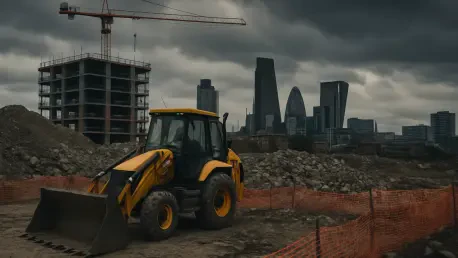The UK construction industry stands at a precipice, with cranes idle and project sites eerily quiet across the nation, signaling a deep crisis as the Autumn Budget nears. A chilling statistic looms large: the S&P Global Purchasing Managers Index (PMI) for construction recorded a score of 46.2 in September, marking nine consecutive months below the 50.0 threshold that signals growth. This persistent downturn paints a grim picture of an industry in distress, grappling with uncertainty and mounting pressures. What forces are driving this decline, and how might the upcoming fiscal announcements shape the sector’s fate? The answers lie in a complex web of economic challenges and policy anticipation.
A Sector on Edge: Unpacking the Construction Crisis
The construction sector in the UK is teetering under the weight of prolonged contraction. Despite the PMI inching up to its highest level in three months, the figure remains stubbornly below the growth mark, reflecting a deep-seated lack of activity. Firms are hesitating to launch new projects, casting a shadow over an industry that once fueled economic momentum. This stagnation isn’t just a number on a chart; it’s a tangible reality felt on building sites from London to Manchester, where the hum of progress has dulled.
Beyond the raw data, the mood within the industry is palpably tense. Business confidence has plummeted to its lowest since December 2022, driven by fears of what the Autumn Budget might—or might not—deliver. Many companies are caught in a holding pattern, delaying decisions on major capital expenditures until clearer signals emerge from the government. This paralysis is not merely a business concern but a symptom of broader economic unease gripping the nation.
The Bigger Picture: Ripple Effects of a Stalled Industry
Construction’s struggles extend far beyond its own boundaries, sending shockwaves through the UK economy. This sector is a cornerstone of job creation and infrastructure development, and its downturn threatens livelihoods and critical projects alike. With commercial builds grinding to a halt and residential developments faltering, delays in essential public works could hinder long-term growth and community well-being.
Moreover, the timing of this slump adds urgency to the situation. As Chancellor Rachel Reeves prepares to unveil fiscal plans, the construction industry’s woes mirror deeper national uncertainties. A faltering sector risks amplifying economic instability, particularly when paired with parallel declines in services and manufacturing. The stakes are high for policymakers to address these interconnected challenges before the damage becomes irreparable.
Breaking Down the Crisis: Forces Behind the Downturn
Several overlapping factors are dragging construction into a quagmire. Economic uncertainty tops the list, with firms reluctant to commit to large-scale projects amid ambiguity over the Budget’s direction. This hesitation has created a vicious cycle, where low confidence stifles investment, further deepening the sector’s woes. The lack of clarity from fiscal authorities is a key barrier to recovery.
Adding to the strain are shrinking workloads and a scarcity of new contracts, especially in commercial construction, which is declining at the fastest rate among sub-sectors. Residential and civil engineering projects are also losing ground, leaving little room for growth. Meanwhile, cost pressures are intensifying, fueled by policy changes such as the higher national minimum wage and increased employers’ National Insurance Contributions (NICs). These measures, while aimed at broader social benefits, are squeezing already tight profit margins. Compounding the issue, employment has taken a hit, with job cuts persisting for nine straight months as companies scale back under financial duress.
Voices from the Ground: Industry Insights and Broader Implications
Industry experts are sounding the alarm over construction’s bleak outlook. Tim Moore, Economics Director at S&P Global Market Intelligence, has highlighted “weak business optimism” across all segments, from residential to commercial. His analysis points to a pervasive sense of caution, driven by economic uncertainty and delayed policy decisions. This sentiment is echoed on the ground, where project managers and contractors describe a landscape of stalled ambitions and tightening budgets.
Yet, amidst the gloom, a sliver of hope persists among a small fraction of firms anticipating a post-Budget rebound. However, this optimism is overshadowed by widespread pessimism, as most stakeholders brace for tougher times ahead. The construction sector’s challenges are not isolated; similar struggles in services—where activity has slowed to a five-month low—and manufacturing, disrupted by events like a cyber attack on Jaguar Land Rover, suggest a broader economic malaise. This interconnected downturn underscores the urgent need for targeted interventions.
Navigating the Storm: Strategies for Construction Stakeholders
While the Autumn Budget holds potential for change, construction firms and stakeholders must act now to safeguard their futures. One approach is to pivot toward smaller, less capital-intensive projects that can sustain cash flow during this period of uncertainty. Such strategic planning allows companies to remain agile while awaiting clearer fiscal guidance.
Cost management is another critical focus. Reviewing operational expenses and renegotiating supplier contracts can help offset the burden of rising costs and policy-driven financial pressures. Additionally, adopting flexible staffing models, such as temporary hires, offers a way to balance workforce needs without overcommitting in a volatile market. Engaging with industry bodies to advocate for supportive Budget measures is equally vital, ensuring the sector’s voice shapes policy outcomes. Finally, exploring diversification into niche areas like sustainable retrofitting could open new revenue streams, cushioning the impact of traditional workload declines.
Reflecting on this challenging chapter, the UK construction industry faced a relentless storm of economic uncertainty and operational hurdles. The persistent decline in activity, coupled with fading business confidence, left an indelible mark on a sector vital to national progress. Looking back, the urgency for resilience was clear, as firms grappled with shrinking workloads and policy pressures. Moving forward, the path to recovery hinged on actionable strategies—streamlining costs, adapting workforce models, and pushing for supportive policies. Beyond immediate survival, the industry’s revival rested on fostering innovation and seizing emerging opportunities, ensuring that past struggles paved the way for a stronger, more adaptive future.









